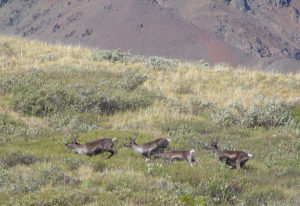
The fable about reindeer living at the North Pole is almost true. They don’t live right on the Pole, but indigenous migrating wild herds today live in or near the Arctic Circle, and semi-domesticated herds reach only a bit further south. In North America, migrating caribou species, which are similar to reindeer, live in northern Canada and Alaska. The non-migrating Boreal Woodland Caribou, extending into the southern Canadian provinces, and the Wild Forest Reindeer of the Russian Altai-Sayan region (bordering Mongolia) are endangered.
Reindeer migrate in late spring from taiga to tundra, where they have their babies relatively isolated from predators. After giving birth, the females shed their antlers. Males by this time have long disposed of their heavier antlers, which would make the dangerous spring migration across hundreds of miles more cumbersome. Females and juveniles keep their antlers through the winter to dig through snow and brush seeking nourishment. An elder doe leads the herd on the trek north. Reindeer hooves are well adapted to ice and slippery bog, and reindeer are strong swimmers. In the northern territory the calves fatten with the rest of the herd on lichen and other tundra vegetation. During the fall and winter, in the scrubby forests of the taiga, they will also eat berries, willow, birch, grasses, and other forest plants. Their eyes undergo structural changes as the year darkens, allowing them to utilize the light waves they screened out during the glaring arctic summer.
Next week: Reindeer in the Ice Age.

